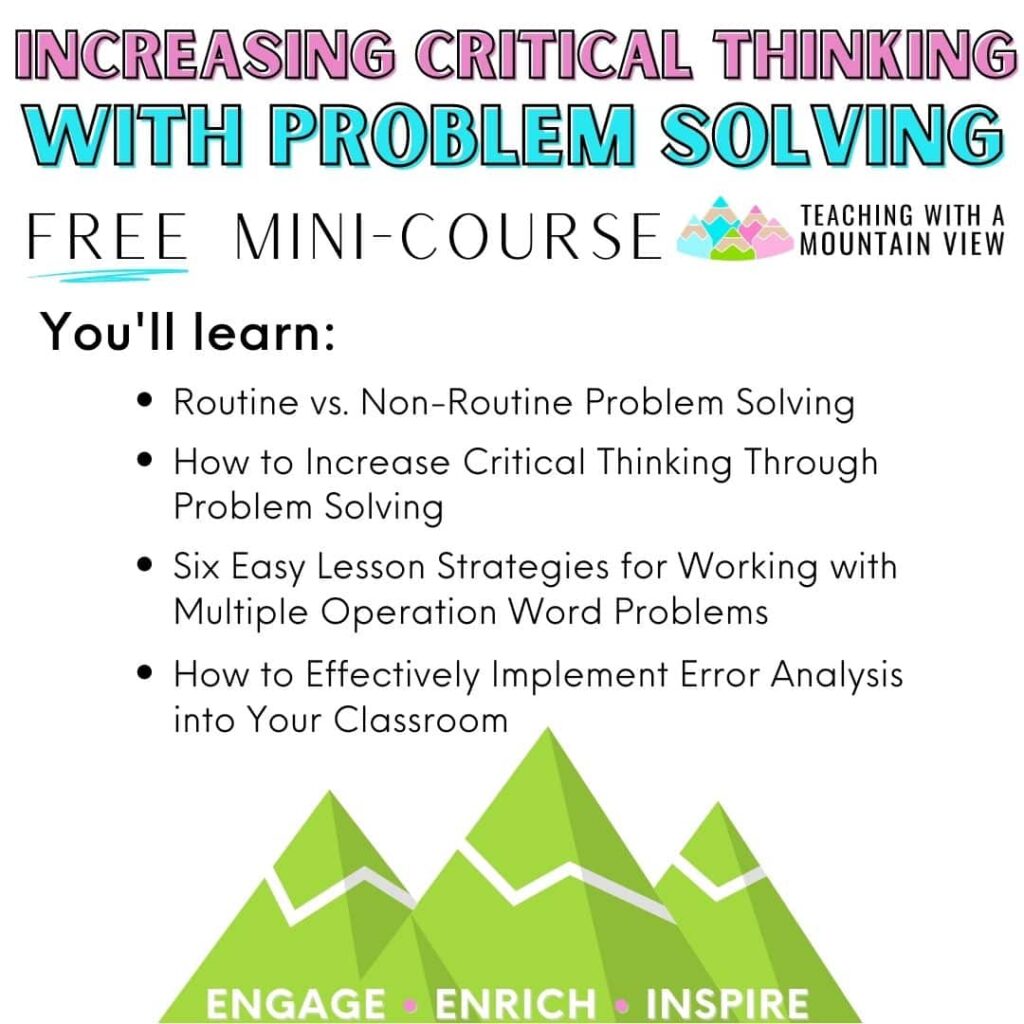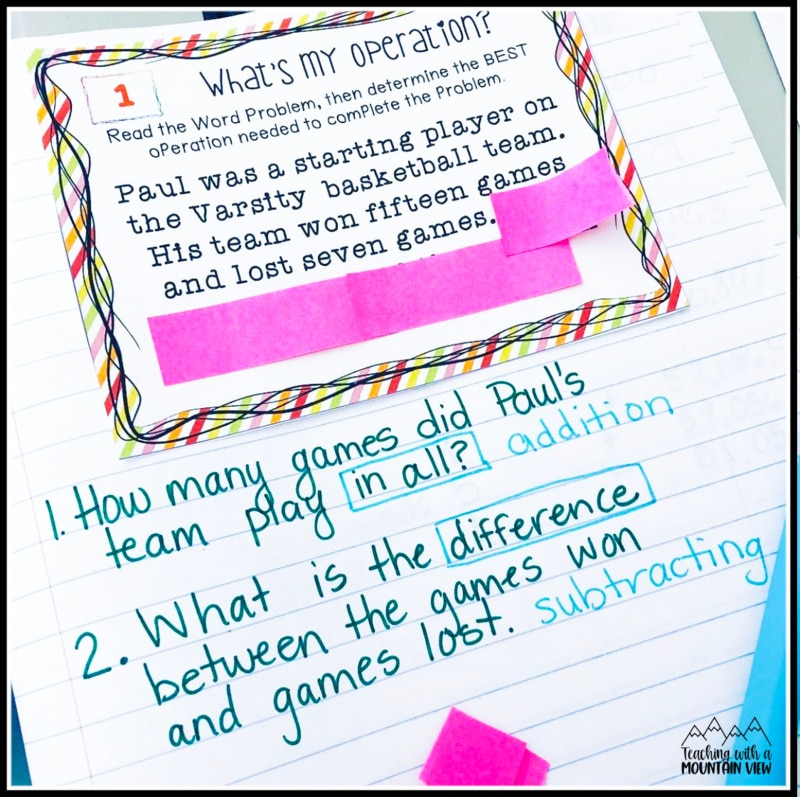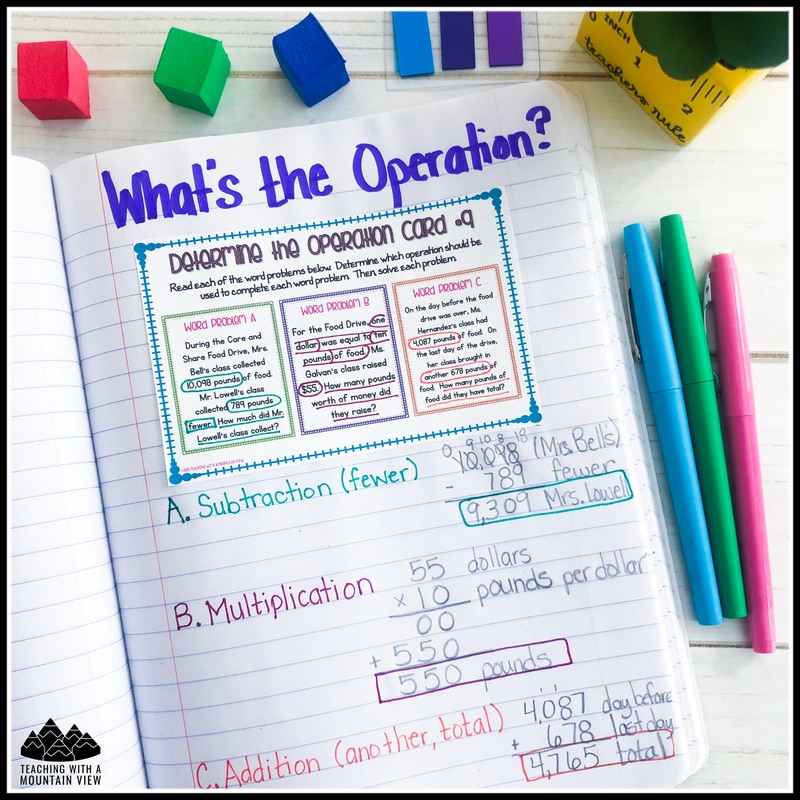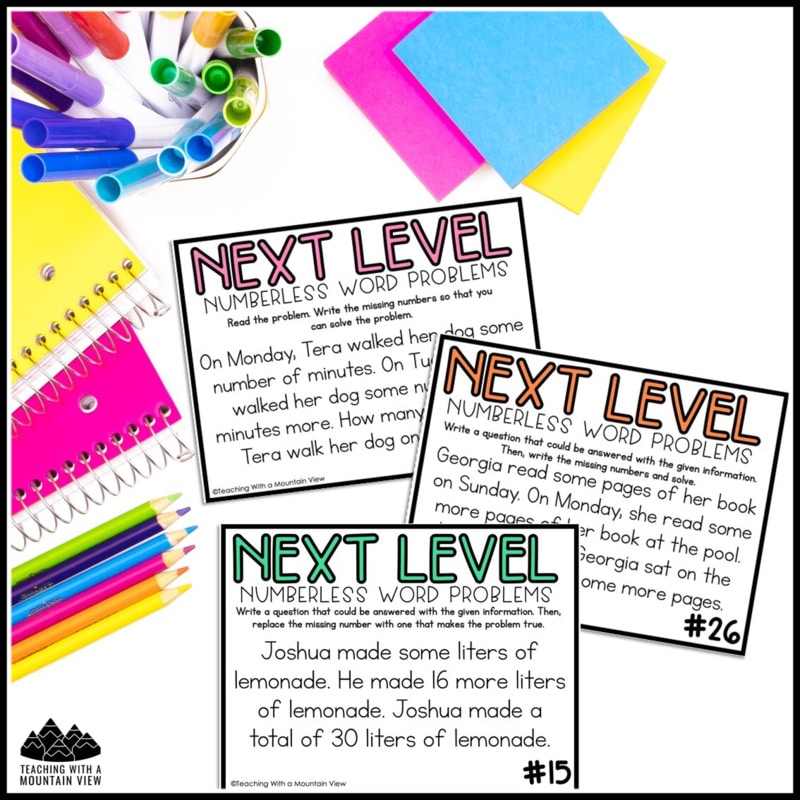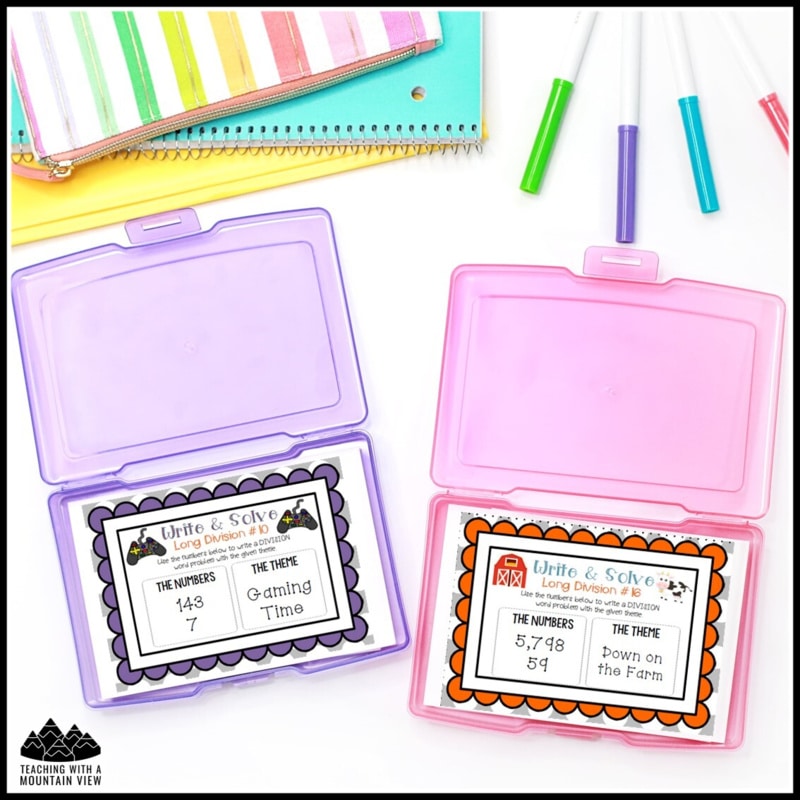6 Strategies for Increasing Critical Thinking with Problem Solving
By Mary Montero
Share This Post:
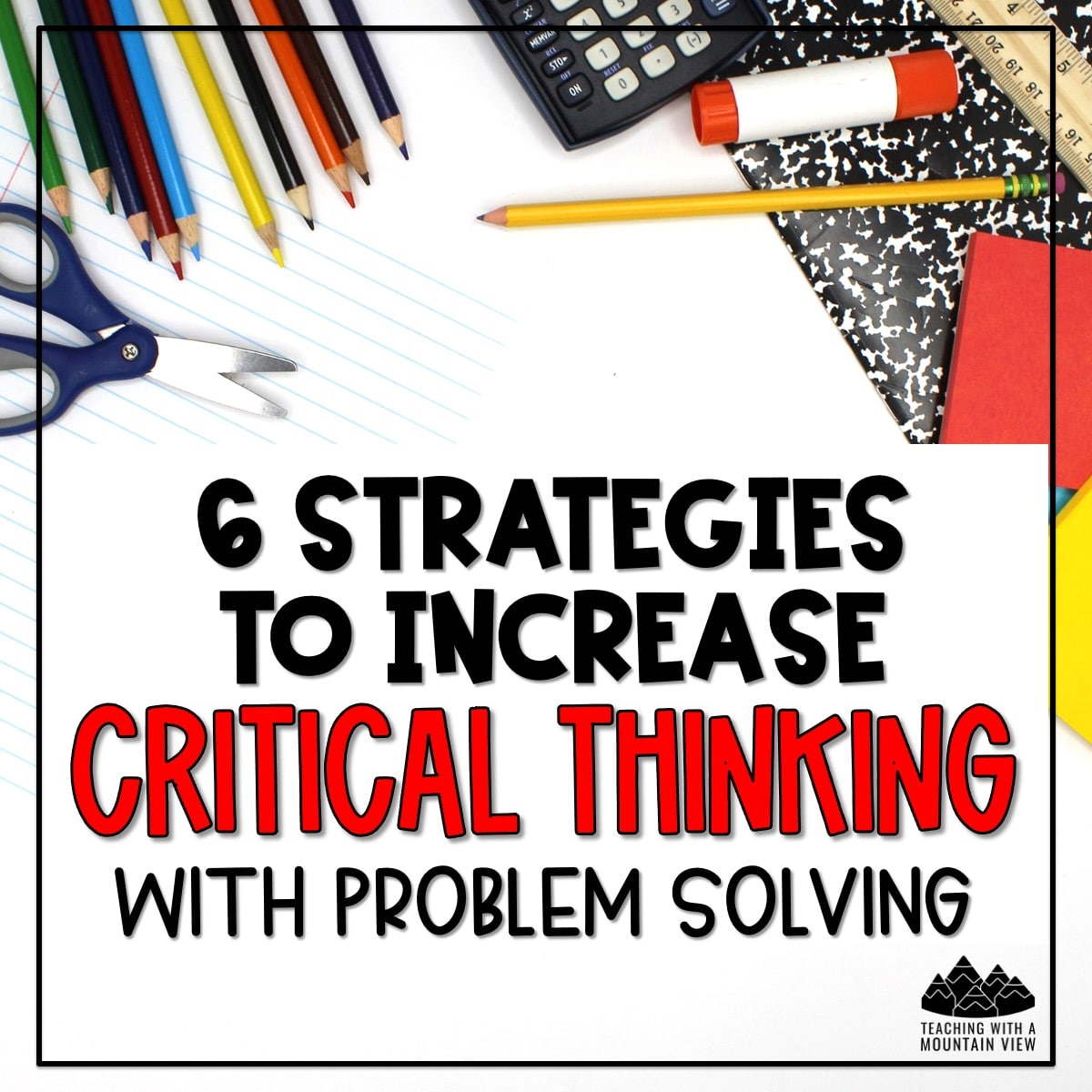
For many teachers, problem-solving feels synonymous with word problems, but it is so much more. That’s why I’m sharing my absolute favorite lessons and strategies for increasing critical thinking through problem solving below. You’ll learn six strategies for increasing critical thinking through mathematical word problems, the importance of incorporating error analysis into your weekly routines, and several resources I use for improving critical thinking – almost all of which are free! I’ll also briefly touch on teaching students to dissect word problems in a way that enables them to truly understand what steps to take to solve the problem.
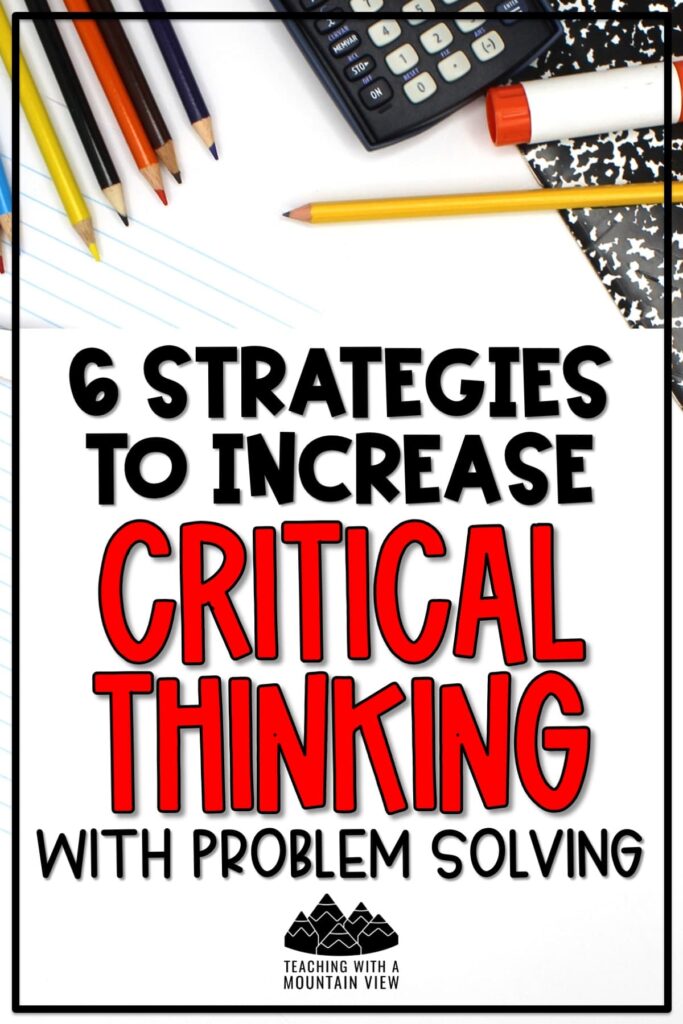
This post is based on my short and sweet (and FREE!) Increasing Critical Thinking with problem Solving math mini-course. When you enroll in the free course you’ll get access to everything you need to get started:
- Problem Solving Essentials
- Six lessons to implement into your classroom
- How to Implement Error Analysis
- FREE Error Analysis Starter Kit
- FREE Mathematician Posters
- FREE Multi-Step Problem Solving Starter Kit
- FREE Task Card Starter Kit
Introduction to Critical Thinking and Problem Solving
According to the National Council of Teachers of Mathematics, “The term “problem solving” refers to mathematical tasks that have the potential to provide intellectual challenges for enhancing students’ mathematical understanding and development.)”
That’s a lot of words, but I’d like to focus in on the word POTENTIAL. I’m going to share with you strategies that move these tasks from having the potential to provide a challenge to actually providing that challenge that will enrich their mathematical understanding and development.
If you’re looking for an introduction to multi-step problem solving, I have a free multi-step problem solving starter kit for that!
I also highly encourage you to download and use my free Mathematician posters that help students see what their “jobs” are as mathematicians. Giving students this title of mathematician not only holds them accountable, but it gives them greater confidence and gives me very specific verbiage to use when discussing math with my students.
The impacts of Incorporating Problem Solving
When I made the shift to incorporate problem solving into my everyday instruction intentionally, I saw a distinct increase in student understanding and application of mathematical concepts, more authentic connections to real-world mathematics scenarios, greater student achievement, and notably increased engagement. There are also ripple effects observed in other areas, as students learn grit and a growth mindset after tackling some more challenging problem-solving situations. I hope that by implementing some of these ideas, you see the very same shift.
Here’s an overview of some problem solving essentials I use to teach students to solve problems.
Routine vs. Non-Routine Problem Solving
Routine problems comprise the vast majority of the word problems we pose to students. They require using an algorithm through one or more of the four major operations, have relevance to real-world situations, and often have a distinct answer. They are solvable, and students can use several concrete strategies for solving, like “make a table” or “draw a picture” to solve.
Conversely, non-routine problem-solving focuses on mathematical reasoning. These are often more open-ended and allow students to make generalizations about math and numbers. There isn’t usually a straight path leading to the answer, there isn’t an algorithm readily available for finding the solution (or students are going to have to come up with the algorithm), and it IS going to require some level of experimentation and manipulation of numbers in order to solve it. In non-routine problems, students learn to look for patterns, work backwards, build models, etc.
Incorporating both routine and non-routine problems into your instruction for EVERY student is critical. When solving non-routine problems, students can use some of the strategies they’ve learned for solving routine problems, and when solving routine problems, students benefit from a deeper understanding of the complexity of numbers that they gained from non-routine problems. For this training, we will focus heavily on routine problems, though the impacts of these practices will transition into non-routine problem solving.
Increasing Critical Thinking in Problem Solving
When tackling a problem, students need to be able to determine WHAT to do and HOW to do it. Knowing the HOW is what you likely teach every day – your students know how to add, subtract, multiply, and divide. But knowing WHAT to do is arguably the most essential part of solving problems – once students know what needs to be done, then they can apply the conceptual skills – the algorithms and strategies – they’ve learned and will know how to solve. While dissecting word problems is an excellent starting point, exposing students to various ways to examine problems can help them figure out the WHAT.
Being faced with a lengthy, complex word problem can be intimidating to even your most adept students. Having a toolbox of strategies to use when you tackle problems and seeing problems in various ways can enable students to get to the point where they feel comfortable knowing where to begin.
Shifting away from keywords
While it isn’t best practice to rely solely on operation “keywords” to determine what operation needs to occur when solving a problem, I’m not ready to fully ditch keyword-based instruction in math. I think there’s a huge difference between teaching students to blindly rely on keywords to determine which operation to use for a solution and using words found in the text to guide students in figuring out what to do. For that reason, I place heavy emphasis on using precise mathematical vocabulary, including specific operation keywords, and when students become accustomed to using that precise mathematical vocabulary every day, it really helps them to identify that language in word problems as well.
I also allow my students to dissect math word problems using strategies like CUBES, but in a way that is more aligned with best practice.
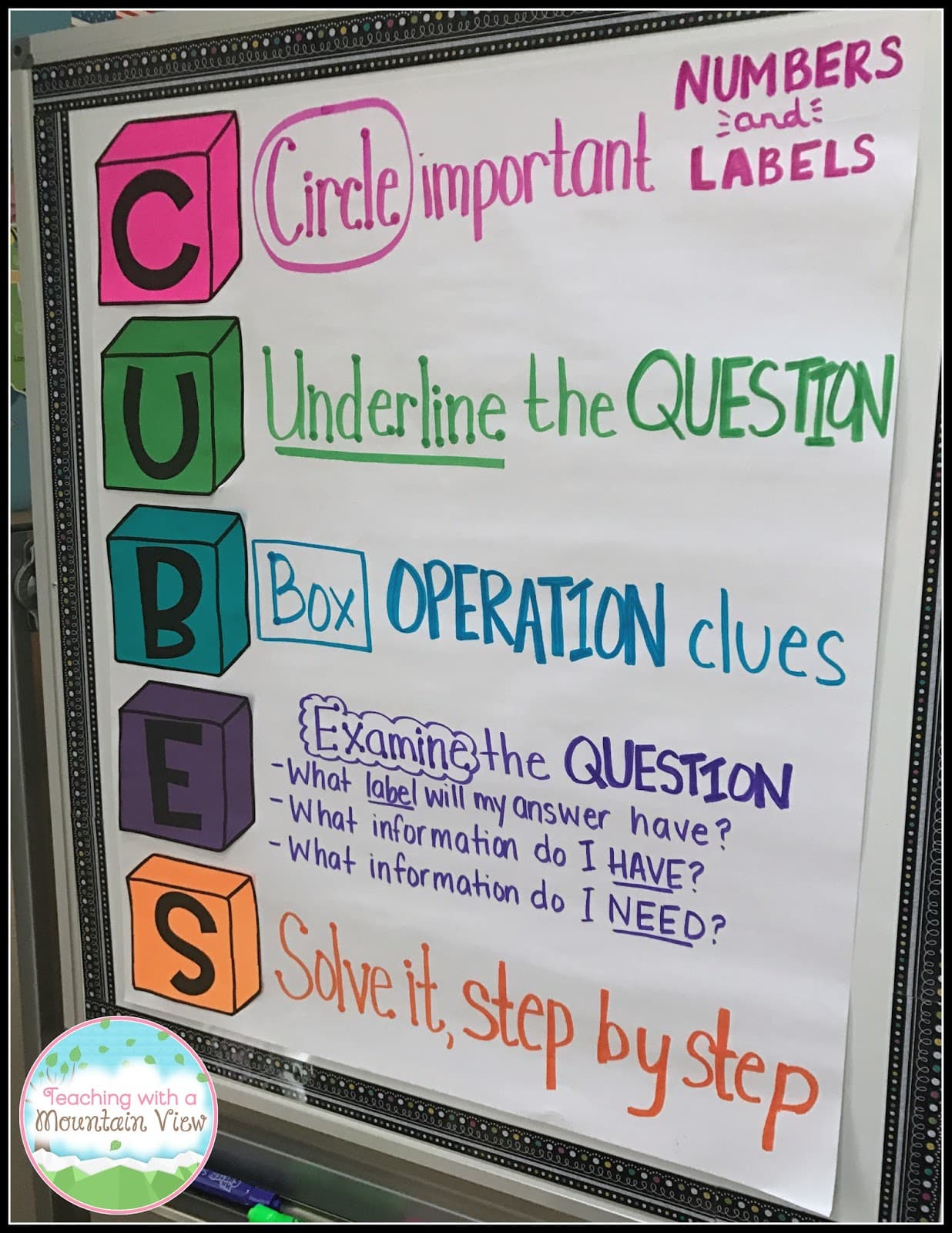
Six Lessons for Easy Implementation
Here are six super quick “outside the box” word problem, problem solving lessons to begin implementing into your classroom. These lessons shouldn’t replace your everyday problem solving, but are instead extensions that will help students tackle those tricky problems they encounter everyday. As a reminder, we look at all of these lessons in the FREE Increasing Critical Thinking with problem Solving math mini-course.
Lesson #1: What’s the Question?
In this lesson, we’ll encourage students to see. just how many different questions can be asked about the same statements or information. We start with a typical, one-step, one-operation problem. Then we cross out or cover up the answer and ask students to generate possible questions.
After students have come up with a variety of questions, ask them to determine HOW they would solve for each one.
Reveal the question and ask students how they would solve this one and see if any of the questions they came up with match.
This activity is important because it demonstrates to students just how many different questions can be asked about the same statement or information. It’s perfect for your students who automatically pick out numbers and start “operating” on them blindly. I’ve had students come up with 5-8 questions with a single statement!
I like to do this throughout the year using different word problems based on the skill we’re focused on at the time AND skills we’ve previously mastered, but be careful not to only use examples based on the skill you’re teaching right then so their brains don’t automatically go to the same place.
These 32 What’s My Operation? task cards will help your student learn and review which operations to use for different types of word problems! They’re perfect to use as a quick assessment, game of SCOOT, math center activity, or homework.
Lesson 2: Similar Scenarios
In this lesson, students will evaluate similar scenarios to determine the appropriate operations. Start with three similar scenarios requiring different operations and identify what situation is happening in each scenario (finding total, determining an amount, splitting or combining, etc.).
Read all three-word problems on a similar topic. Determine the similarity of all of them and determine which operation would be used to solve them. How does the situation/action of the problem help you determine what step to take?
I also created these differentiated word problem task cards after noticing my students struggling with which operation to choose, especially when given multiple problems from a similar scenario. They encourage students to select the appropriate operation for each word problem.
Lesson 3: Opposing Operations
In this lesson, students will determine relevant information from a set of facts, which requires a great deal of critical thinking to determine which operation to use. Give students a scenario and a variety of facts/information relating to the scenario as well as several questions to answer based on the facts. Students will focus on determining HOW they will solve each question using only the relevant information.
These Operation Fascination task cards engage students in critical thinking about operations. Each card has a scenario, multiple clues and facts to support the scenario, and four questions to accompany each scenario. The questions are a variety of operations so that students can see how using the same information can solve multiple problems.
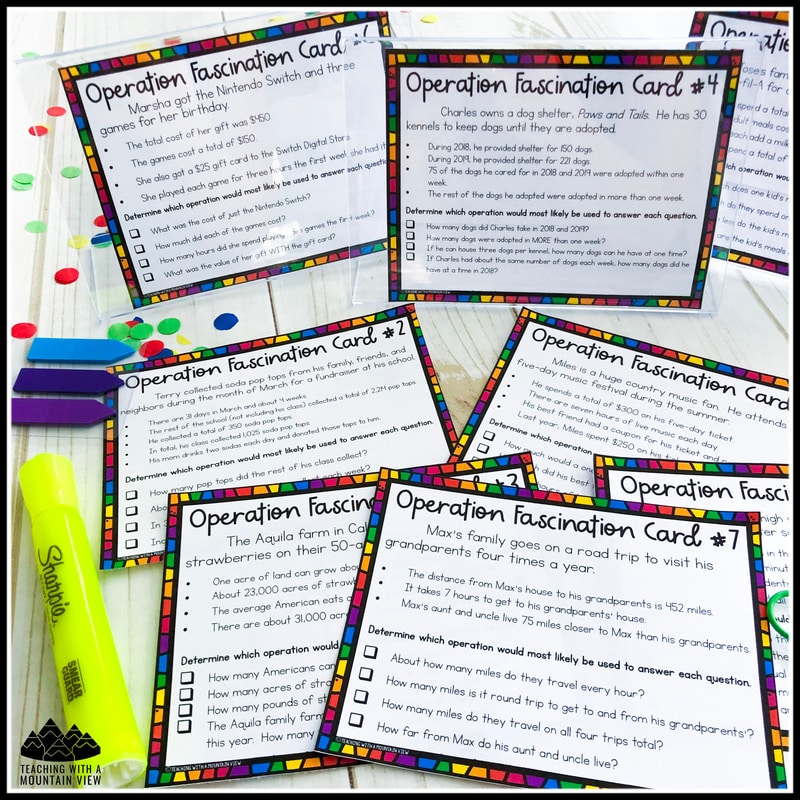
Lesson 4: Next Level Numberless
In this lesson, we’ll take numberless word problems to the next level by developing a strong conceptual understanding of word problems. Give students scenarios without numbers and have them write a question and/or insert numbers using a specific operation and purpose. This requires a great deal of thinking to not only determine the situation, but to also figure out numbers that fit into the situation in a way that makes sense.
By integrating these types of math problems into your daily lessons, you can significantly enhance your students’ comprehension of word problems and problem-solving. These numberless word problem task cards are the ideal to improve your students’ critical thinking and problem-solving skills. They offer a variety of numbered and numberless word problems.
Lesson 5: Story Situations
In this lesson, we’ll discuss the importance of students generating their own word problems with a given set of information. This requires a great deal of quantitative reasoning as students determine how they would use a given set of numbers to create a realistic situation. Present students with two predetermined numbers and a theme. Then have students write a word problem, including a question, using the given information.
Engage your students in additional practice with these differentiated division task cards that require your students to write their OWN word problems (and create real-world relevance in their learning!). Each task card has numbers and a theme that students use to guide their thinking and creation of a word problem.
Lesson 6: No Scenario Solving
In this lesson, we’ll decontextualize problem solving and require students to create the situation, represent it numerically, and solve. It’s a cognitively demanding task! Give students an operation and a purpose (joining, separating, comparing, etc.) with no other context, numbers, numbers, or theme. Then have students generate a word problem.
For additional practice, have students swap problems to identify the operation, purpose, and solution.
Implementing Error Analysis
Error analysis is an exceptional way to promote thinking and learning, but how do we teach students to figure out which type of math error they’ve made? This error analysis starter kit can help!
First, it is very rare that I will tell my students what error they have made in their work. I want to challenge them to figure it out on their own. So, when I see that they have a wrong answer, I ask them to go back and figure out where something went wrong. Because I resist the urge to tell them right away where their error is, my students tend to get a lot more practice identifying them!
Second, when I introduce a concept, I always, always, always create anchor charts with students and complete interactive notebook activities with them so that they have step-by-step procedures for completing tasks right at their fingertips. I have them go back and reference their notebooks while they are looking at their errors. Usually, they can follow the anchor chart step-by-step to make sure they haven’t made a conceptual error, and if they have, they can identify it.
Third, I let them use a calculator. When worst comes to worst, and they are fairly certain they haven’t made a conceptual mistake to identify, I let them get out a calculator and start computing, step-by-step to see where they’ve made a mistake.
IF, after taking these steps, a student can’t figure out their mistake (especially if I find that it’s a conceptual mistake), I know I need to go back and do some individual reteaching with them because they don’t have a solid understanding of the concept.
This FREE addition error analysis is a good place to start, no matter the grade level. I show them the process of walking through the problem and how best to complete an error analysis task.
Digging Deeper into Error Analysis
Once students show proficiency in the standard algorithm (or strategies), I take it a step further and have them dive into error analysis where they can show a “reverse” understanding as they evaluate mistakes made and fix them. Being able to identify an error in someone else’s work requires higher order thinking not found in most other projects or activities and certainly not found in basic math fact completion.
First, teach students the difference between a computational error and a conceptual error.
- Computational is when they make a mistake in basic math facts. This might look as simple as 64/8 does not equal 7. Oops!
- A Conceptual or Procedural Error is when they make a mistake in the procedure or concept.
- I can’t tell you how many times students show as not proficient on a topic when the mistakes they are making are COMPUTATIONAL and not conceptual or procedural. They don’t need more review in how to use a strategy… they need to slow down and pay closer attention to their math facts!
Once we’ve introduced the types of errors they should be looking out for, we move on to actually analyzing these errors in someone else’s work and fixing the mistake.
I have created error analysis tasks for you to use with you students so they can identify the errors, types of errors, rework the problem, and create their own version of the problem and solve it. I have seen great success with incorporating these tasks into ALL of my math units. I even have kids beg to take their error analysis tasks out to recess to finish! These are great resources to start:
- Error Analysis Bundle
- 3rd Grade Word Problem of the Day
- 4th Grade Word Problem of the Day
- 5th Grade Word Problem of the Day
The final step in using error analysis is actually having students correct their OWN mistakes. Once I have instructed on types of errors, I will start by simply telling them, Oops! You’ve made a computational error here! That way they aren’t furiously looking through the procedure for a mistake, instead they are looking to see where they computed wrong. Conversely, I’ll tell them if they’ve made a procedural mistake, and that can guide them in figuring out what they need to look for.
Looking at the different types of errors students are making is essential to guiding my instruction as well, so even though it takes a bit longer to grade things like this, it is immensely helpful to me as I make adjustments to my instruction.
Resources and Ideas for Critical Thinking
I’ve compiled a collection of websites for complex tasks with multiple, open-ended answers and scenarios. The majority of these tasks are non-routine and so easy to implement. I often post these tasks and allow students short bursts of time to strategize and plan for a solution. Consider using the tasks and problems from these sites as warm-ups, extensions of your morning meeting, during enrichment groups, or on a Problem of the Week board. I also highly encourage you to incorporate these non-routine problems into your core instruction time for all students at least once or twice a month.
- NRICH provides thousands of FREE online mathematics resources for ages 3 to 18. The tasks focus on developing problem-solving skills, perseverance, mathematical reasoning, the ability to apply knowledge creatively in unfamiliar contexts, and confidence in tackling new challenges..
- Open Middle offers challenging math word problems that require a higher depth of knowledge than most problems that assess procedural and conceptual understanding. They support the Common Core State Standards and provide students with opportunities for discussing their thinking. All problems have a “closed beginning,” meaning that they all start with the same initial problem, a “closed-end” meaning that they all end with the same answer, and an “open middle” meaning that there are multiple ways to approach and ultimately solve the problem.
- Mathcurious offers interactive digital puzzles. Each adventure is dedicated to exploring the world of math and sharing experiences, knowledge, and ideas.
- Robert Kaplinsky shares math strategies, lessons, and resources designed to create problem solvers. The lessons are detailed and challenging!
- Mathigon “The mathematical playground” offers free manipulatives, activities, and lessons to make online learning interactive and engaging. The digital manipulates are a must-use!
- Fractal Foundation uses fractals to inspire interest in science, math and art. It has numerous fractal activities, software to help your students create their own fractals, and more.
- Greg Fletcher 3 Act Tasks contain engaging math videos with guiding questions. You can also download recording sheets to go with each video.
Mary Montero
I’m so glad you are here. I’m a current gifted and talented teacher in a small town in Colorado, and I’ve been in education since 2009. My passion (other than my family and cookies) is for making teachers’ lives easier and classrooms more engaging.







